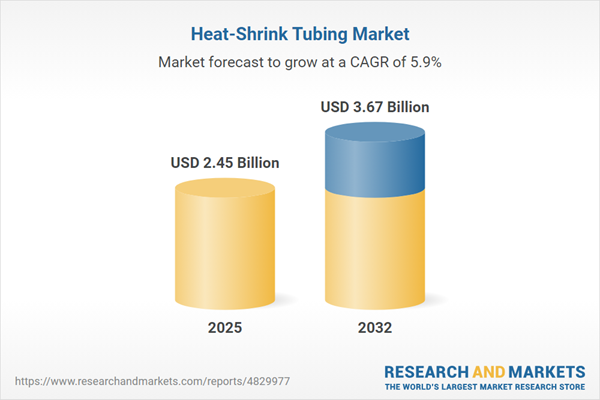Speak directly to the analyst to clarify any post sales queries you may have.
The heat-shrink tubing market presents critical solutions for insulation, environmental sealing, and strain relief, enabling enterprises across a variety of industries to enhance reliability, safety, and compliance amid evolving engineering and regulatory demands.
Market Snapshot: Steady Growth and Broad Industry Uptake
The Heat-Shrink Tubing Market grew from USD 2.31 billion in 2024 to USD 2.45 billion in 2025. Sustained by a CAGR of 5.93%, this sector is projected to achieve USD 3.67 billion by 2032.
This trajectory reflects increasing requirements for high-performance cable protection and system integrity in sectors including aerospace, medical devices, telecommunications, and energy infrastructure. Strong demand for advanced materials and solutions that comply with stringent standards highlights heat-shrink tubing’s role in future-focused industry landscapes.Scope & Segmentation: In-Depth Analysis Across Technologies, Applications, and Geographies
- Material: Fluoropolymer, Polyolefin, PTFE, PVC, Silicone
- Shrink Ratio: 2:1, 3:1, 4:1, 6:1
- Wall Thickness: Heavy Wall, Standard Wall, Thin Wall
- Operating Temperature: High Temperature, Low Temperature, Standard Temperature
- End User Industry: Aerospace and Defense, Automotive, Consumer Goods, Electrical and Electronics, Medical Devices, Oil and Gas, Telecommunications
- Application: Bundling and Strain Relief, Corrosion Protection, Environmental Sealing, Insulation and Identification
- Regional Coverage: Americas (United States, Canada, Mexico, Brazil, Argentina, Chile, Colombia, Peru), Europe (United Kingdom, Germany, France, Russia, Italy, Spain, Netherlands, Sweden, Poland, Switzerland), Middle East (United Arab Emirates, Saudi Arabia, Qatar, Turkey, Israel), Africa (South Africa, Nigeria, Egypt, Kenya), Asia-Pacific (China, India, Japan, Australia, South Korea, Indonesia, Thailand, Malaysia, Singapore, Taiwan)
- Key Companies Profiled: TE Connectivity Ltd., 3M Company, Prysmian S.p.A., Sumitomo Electric Industries, Ltd., ABB Ltd., Parker-Hannifin Corporation, Amphenol Corporation, Molex LLC, Nexans S.A., HellermannTyton Ltd.
Key Takeaways: Strategic Insights for Senior Decision-Makers
- Material science advancements, including nano-reinforced and bio-based polymers, are instrumental in tailoring performance for demanding applications and stricter safety standards.
- Adoption of digital manufacturing and Industry 4.0 practices improves process control, reduces downtime, and accelerates innovation in product development and market delivery.
- Cross-functional collaboration among R&D, engineering, and supply chain leaders is essential to anticipate next-generation requirements and support differentiation.
- Regional focus on supply resilience, sustainability, and compliance drives both local extrusion capacities and material reformulation to align with regulatory priorities.
- Strategic acquisitions and digital customer engagement platforms are shaping competitive advantage and deepening market reach for industry incumbents.
Tariff Impact: Navigating Policy Shifts in Heat-Shrink Tubing Supply Chains
The imposition of U.S. tariffs in 2025 created pronounced shifts in procurement and distribution strategies. Market participants responded by diversifying sourcing to non-tariffed regions, pursuing nearshoring, and consolidating operations to mitigate rising costs and supply disruptions. This environment has spurred ongoing process optimization and made lean manufacturing and advanced digital procurement an imperative for sustaining competitiveness and agility.
Methodology & Data Sources
The conclusions in this heat-shrink tubing market report are grounded in structured executive interviews, in-depth technical and industry document reviews, and quantitative data triangulation. A panel of subject-matter experts conducted a final peer review to ensure integrity and objectivity.
Why This Report Matters for Heat-Shrink Tubing Stakeholders
- Enables leadership to benchmark technology adoption and anticipate regulatory and policy-driven market changes for robust strategic planning.
- Provides a framework for segment-based growth strategies based on application, end-use industry, and regional dynamics in the global heat-shrink tubing market.
- Delivers practical recommendations for aligning innovation, supply chains, and customer engagement within a shifting global landscape.
Conclusion
With evolving regulatory, technology, and application landscapes, heat-shrink tubing market participants must focus on diversification, innovation, and agility to realize opportunities and manage risks. Informed, proactive strategies will determine long-term resilience and relevance across key industries.
Additional Product Information:
- Purchase of this report includes 1 year online access with quarterly updates.
- This report can be updated on request. Please contact our Customer Experience team using the Ask a Question widget on our website.
Table of Contents
3. Executive Summary
4. Market Overview
7. Cumulative Impact of Artificial Intelligence 2025
Companies Mentioned
The companies profiled in this Heat-Shrink Tubing market report include:- TE Connectivity Ltd.
- 3M Company
- Prysmian S.p.A.
- Sumitomo Electric Industries, Ltd.
- ABB Ltd.
- Parker-Hannifin Corporation
- Amphenol Corporation
- Molex LLC
- Nexans S.A.
- HellermannTyton Ltd.
Table Information
| Report Attribute | Details |
|---|---|
| No. of Pages | 194 |
| Published | October 2025 |
| Forecast Period | 2025 - 2032 |
| Estimated Market Value ( USD | $ 2.45 Billion |
| Forecasted Market Value ( USD | $ 3.67 Billion |
| Compound Annual Growth Rate | 5.9% |
| Regions Covered | Global |
| No. of Companies Mentioned | 11 |









